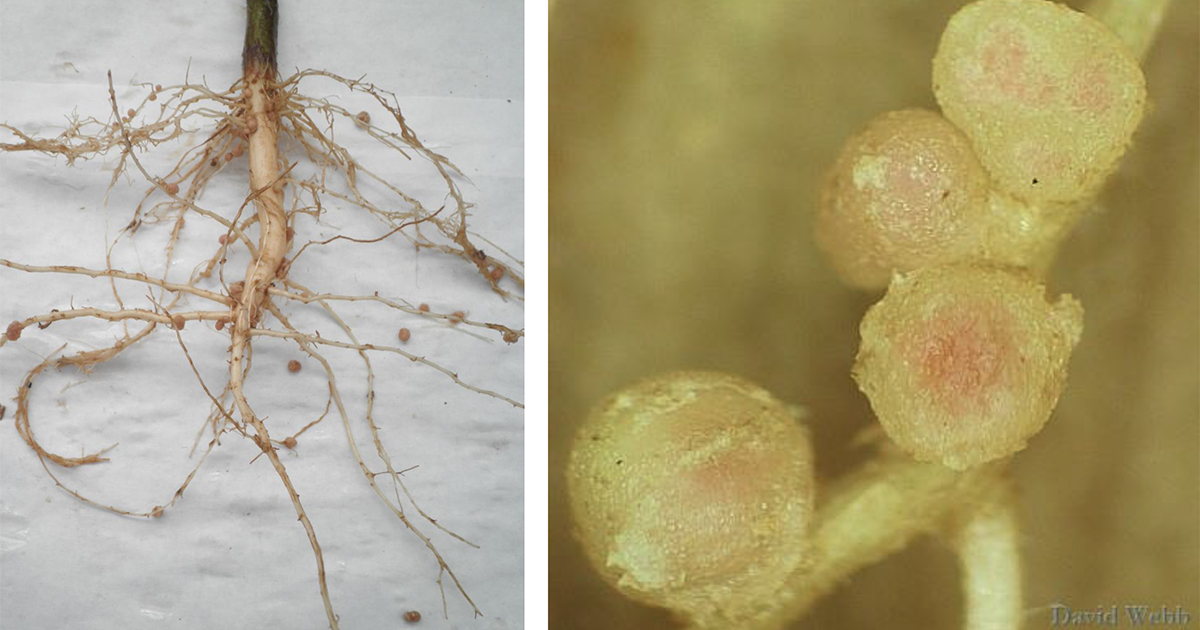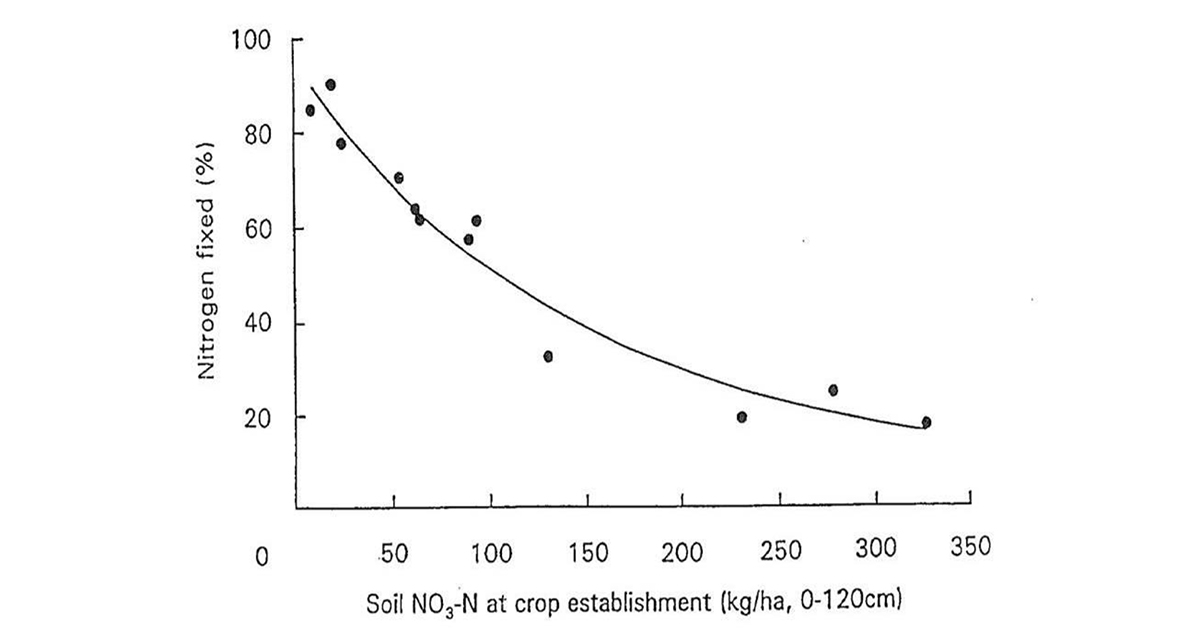Maximising nitrogen fixation in your crop
Source Nikki Seymour, DAF Qld
Good agronomy + Good inoculation = Good N fixation
- Generally, N fixation is related to the biomass of the crop so the bigger the crop the more N is fixed
- Agronomic practices that optimise plant growth will maximise N fixation
- Inoculants need careful handling as they contain live bacteria
- Poor nodulation can lead to N deficient crops, reduced grain protein and yield
 Rhizobium nodules on roots.
Rhizobium nodules on roots.
Good Agronomy
- Good drainage – waterlogging can reduce N fixation and increase denitrification
- Minimise or eliminate N fertiliser – soybeans generally don’t need fertiliser (perhaps useful in heavy trash or late planting situations) and more than 15kg/ha can risk reducing nodulation
- Choose appropriate variety, row spacing and plant population – this work was the focus of GRDC projects in Qld and NSW for soybeans and other pulse crops. Better N fixation relating to best practices for maximising growth, eg if planting late increasing plant population needed to keep N fixation high
Good Inoculation
- Inoculants contain live rhizobia bacteria which are needed to fix the N - need to be handled properly to avoid death
- Keep inoculants cool but don’t freeze them – they are killed by heat so store in fridge or esky
- Inoculate every crop – rhizobia may survive for a year or two after a well-nodulated crop but may be uneven across the paddock
- If inoculating on seed, inoculate just before planting (hours not days) – maximise the number of live bacteria on the seed and hence maximise nodulation
- Where possible, plant into moist, cool soil
- Ensure equipment is clean
- Use an inoculant form that suits your practice – peat, freeze-dried, liquid, granules
- Always follow manufacturer’s instructions
- Look for the green tick logo on inoculant packets -quality assurance through independent testing by AIRG, NSW DPI
- Don’t use out-of-date inoculant
- Do not mix with fertilisers - micronutrients, particularly Zn, Cu or Mg, and high levels of NH3(ammonia)can be toxic
- Don’t directly mix with fungicides, seed dressings (unless stated on label) and herbicides
- Don’t mix with insecticides containing endosulfan, dimethoate, omethoate or carbofuran
- If mixing in water, use good quality, potable water (high or low pH can kill bacteria) and use high rates of water (100-150L/ha)
- Dig up plants 4-6 weeks after planting to check for nodulation. Nodules should be pink inside (not white, green or brown)
 N fixation decreases as soil nitrate increases (Doughton
et al. 1993).
N fixation decreases as soil nitrate increases (Doughton
et al. 1993).
More information:
Contact details:
Nikki Seymour | DAF Qld | 07 46291237 | nikki.seymour@daf.qld.gov.au
Brock Dembowski, Jodie Tubb and Daniel Gonzalez from the Coastal Farming Team (C&FS, DAF) facilitated the series of information sessions to help educate growers in the North about successful inoculation of legumes.
DAF Principal Soil Microbiologist Nikki Seymour (C&FS) presented the information above to growers, industry staff and resellers in the Burdekin, Herbert and Mackay regions. With the planting window for a number of legume crops fast approaching, around 100 people attended the three events with overall positive feedback received from all those who attended. The sessions focused on best management practice to ensure that the legumes develop sufficient nodules to create their own nitrogen source.
Survey data indicated up to 40% change in knowledge in correctly inoculating legumes, with 30 producers now investigating changing their practices in their own operations. The catalyst for the event was derived from a peer to peer (P2P) cane grower group called the Burdekin Field Walk Group, whom recently visited the Darling Downs to see both in field legume production and learn about post farm gate issues. A trip that was made possible by successfully secured funds for through the Enhanced Extension Co-ordination project (RED).
With legume prices hitting all-time highs recently, farmers in the north are beginning to see the value of breaking the monoculture and taking advantage of other higher value crops that can fit in rotation with sugar cane. With substantial increases in legume crops grown during the wet season in North Queensland, growers are not only starting to see benefits to their soil health, they are also reducing their chances of losing top soil through erosion in heavy rainfall events.
Now with the knowledge required to properly inoculate their legume crops, growers will have the confidence to reduce nitrogen application rates in their plant cane crops, which are more likely to be planted several months later following legumes. This will push back fertiliser application in plant cane to April/May, which is a lower risk period for extreme weather events.
Likewise industry staff and resellers can ensure that their clients get the best out of their legumes as the demand increases for these high protein products in both the domestic and international marketplace.

Read Pulse Check blog articles | Pulse Check Coastal facebook | Subscribe to the monthly newsletter

